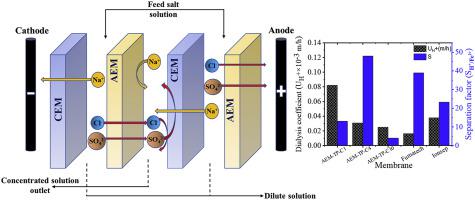当前位置:
X-MOL 学术
›
J. Membr. Sci.
›
论文详情
Our official English website, www.x-mol.net, welcomes your
feedback! (Note: you will need to create a separate account there.)
Crosslinked terpolymer anion exchange membranes for selective ion separation and acid recovery
Journal of Membrane Science ( IF 8.4 ) Pub Date : 2020-10-01 , DOI: 10.1016/j.memsci.2020.118459 Sandip Pal , Rakhi Mondal , Suparna Guha , Uma Chatterjee , Suresh K. Jewrajka
Journal of Membrane Science ( IF 8.4 ) Pub Date : 2020-10-01 , DOI: 10.1016/j.memsci.2020.118459 Sandip Pal , Rakhi Mondal , Suparna Guha , Uma Chatterjee , Suresh K. Jewrajka

|
Abstract Anion exchange membrane (AEM) is useful for the removal of salts via electrodialysis (ED) process. AEM is also used for the recovery of acid from an aqueous feed containing acid and metal ion through diffusion dialysis (DD). However, for the selective separation of monovalent and divalent ions, special type of AEM is required. Herein, we report the preparation of poly(acrylonitrile-co-n-butyl acrylate-co-polydimethylamino ethyl methacrylate) (PAN-co-PnBA-co-PDMA) terpolymer-based crosslinked AEMs for the separation of monovalent ion from bivalent ion via ED process and recovery of hydrochloric acid (HCl) from aqueous feed of HCl and FeCl2 through DD. The slowing down the movement of bivalent anion under electrical potential, and hindering the diffusion of metal ion are the key factors for the optimization of the membranes. The tuning the polarity of the microenvironment of quaternized nitrogen (from DMA moieties) of the terpolymer by changing the length of alkyl chain gave membranes with different monovalent to bivalent anions selectivity, and separation factor for acid recovery. AEM-TP-C1, AEM-TP-C4 and AEM-TP-C10 membranes were prepared by quaternizing the DMA moieties (C1 to C10 denote length of alkyl) of the terpolymer followed by crosslinking. The AEM-TP-C10 membrane exhibited best selectivity (4.76) during desalination of sodium chloride and sodium sulfate mixture (0.01 M, 0.01 M) via ED process. Best performance in terms of acid recovery was obtained with AEM-TP-C4 membrane with dialysis coefficient of 0.031 m/h and separation factor of 38 during acid recovery. The length of alkyl and the hydrophobicity of the environment of the quaternized nitrogen is a governing factor for deciding the performance of the AEMs. This work provides an insight to design crosslinked AEMs for selective separation and acid recovery. The tertiary amine presence in the terpolymer may be quaternized with varieties of halide compounds to further correlate the structure of quaternized amine and property of the AEMs.
中文翻译:

用于选择性离子分离和酸回收的交联三元阴离子交换膜
摘要 阴离子交换膜 (AEM) 可用于通过电渗析 (ED) 工艺去除盐分。AEM 还用于通过扩散渗析 (DD) 从含有酸和金属离子的含水进料中回收酸。然而,对于一价和二价离子的选择性分离,需要特殊类型的 AEM。在此,我们报道了基于聚(丙烯腈-共-丙烯酸正丁酯-共聚-聚甲基丙烯酸二甲氨基乙酯)(PAN-co-PnBA-co-PDMA)三元共聚物的交联 AEM 的制备,用于分离单价离子和二价离子。 ED 工艺和通过 DD 从 HCl 和 FeCl2 的含水进料中回收盐酸 (HCl)。在电位下减缓二价阴离子的运动,阻碍金属离子的扩散是膜优化的关键因素。通过改变烷基链的长度来调整三元共聚物的季铵化氮(来自 DMA 部分)微环境的极性,使膜具有不同的单价至二价阴离子选择性和酸回收分离因子。AEM-TP-C1、AEM-TP-C4 和 AEM-TP-C10 膜是通过季铵化三元共聚物的 DMA 部分(C1 到 C10 表示烷基的长度)然后交联来制备的。AEM-TP-C10 膜在通过 ED 工艺对氯化钠和硫酸钠混合物 (0.01 M, 0.01 M) 进行脱盐过程中表现出最佳选择性 (4.76)。在酸回收过程中,透析系数为 0.031 m/h 且分离系数为 38 的 AEM-TP-C4 膜在酸回收方面获得了最佳性能。烷基的长度和季铵化氮环境的疏水性是决定 AEM 性能的控制因素。这项工作为设计用于选择性分离和酸回收的交联 AEM 提供了见解。三元共聚物中存在的叔胺可以用各种卤化物进行季铵化,以进一步关联季铵化胺的结构和 AEM 的性质。
更新日期:2020-10-01
中文翻译:

用于选择性离子分离和酸回收的交联三元阴离子交换膜
摘要 阴离子交换膜 (AEM) 可用于通过电渗析 (ED) 工艺去除盐分。AEM 还用于通过扩散渗析 (DD) 从含有酸和金属离子的含水进料中回收酸。然而,对于一价和二价离子的选择性分离,需要特殊类型的 AEM。在此,我们报道了基于聚(丙烯腈-共-丙烯酸正丁酯-共聚-聚甲基丙烯酸二甲氨基乙酯)(PAN-co-PnBA-co-PDMA)三元共聚物的交联 AEM 的制备,用于分离单价离子和二价离子。 ED 工艺和通过 DD 从 HCl 和 FeCl2 的含水进料中回收盐酸 (HCl)。在电位下减缓二价阴离子的运动,阻碍金属离子的扩散是膜优化的关键因素。通过改变烷基链的长度来调整三元共聚物的季铵化氮(来自 DMA 部分)微环境的极性,使膜具有不同的单价至二价阴离子选择性和酸回收分离因子。AEM-TP-C1、AEM-TP-C4 和 AEM-TP-C10 膜是通过季铵化三元共聚物的 DMA 部分(C1 到 C10 表示烷基的长度)然后交联来制备的。AEM-TP-C10 膜在通过 ED 工艺对氯化钠和硫酸钠混合物 (0.01 M, 0.01 M) 进行脱盐过程中表现出最佳选择性 (4.76)。在酸回收过程中,透析系数为 0.031 m/h 且分离系数为 38 的 AEM-TP-C4 膜在酸回收方面获得了最佳性能。烷基的长度和季铵化氮环境的疏水性是决定 AEM 性能的控制因素。这项工作为设计用于选择性分离和酸回收的交联 AEM 提供了见解。三元共聚物中存在的叔胺可以用各种卤化物进行季铵化,以进一步关联季铵化胺的结构和 AEM 的性质。











































 京公网安备 11010802027423号
京公网安备 11010802027423号